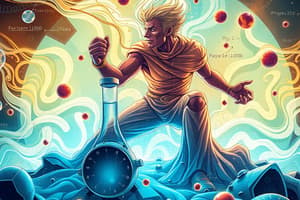Podcast
Questions and Answers
Qual é o conceito crítico em química AP que descreve o equilíbrio entre reagentes e produtos em uma reação reversível?
Qual é o conceito crítico em química AP que descreve o equilíbrio entre reagentes e produtos em uma reação reversível?
- Combustão
- Síntese
- Equilíbrio (correct)
- Decomposição
De acordo com o princípio de Le Chatelier, se um sistema em equilíbrio é submetido a uma mudança de concentração, temperatura ou pressão, como o sistema reage?
De acordo com o princípio de Le Chatelier, se um sistema em equilíbrio é submetido a uma mudança de concentração, temperatura ou pressão, como o sistema reage?
- O sistema converte todos os reagentes em produtos instantaneamente.
- O sistema não reage e permanece inalterado.
- O sistema desloca o equilíbrio para a direção oposta para compensar a mudança. (correct)
- O sistema se desestabiliza e forma mais produtos.
Em que tipo de reação química ocorre a combinação de dois ou mais elementos para formar um composto?
Em que tipo de reação química ocorre a combinação de dois ou mais elementos para formar um composto?
- Substituição simples
- Decomposição
- Combustão
- Síntese (correct)
Quais são os quatro tipos de ligações químicas que podem ser encontradas em química AP?
Quais são os quatro tipos de ligações químicas que podem ser encontradas em química AP?
Qual é o tipo de ligação em que há compartilhamento de elétrons entre átomos para alcançar uma configuração eletrônica estável?
Qual é o tipo de ligação em que há compartilhamento de elétrons entre átomos para alcançar uma configuração eletrônica estável?
Qual é o processo que envolve a oxidação rápida de uma substância, liberando energia?
Qual é o processo que envolve a oxidação rápida de uma substância, liberando energia?
What charge do protons carry?
What charge do protons carry?
Which subatomic particle orbits the nucleus in shells?
Which subatomic particle orbits the nucleus in shells?
Why do atoms tend to lose, gain, or share electrons?
Why do atoms tend to lose, gain, or share electrons?
What does mastering atomic structure and bonding enable chemists to do?
What does mastering atomic structure and bonding enable chemists to do?
Which concept provides a foundation for studying chemistry by explaining chemical reactions and bonding?
Which concept provides a foundation for studying chemistry by explaining chemical reactions and bonding?
What type of chemical reaction involves the combination of elements to form a compound?
What type of chemical reaction involves the combination of elements to form a compound?
In which type of bond do atoms share electrons to achieve a stable electron configuration?
In which type of bond do atoms share electrons to achieve a stable electron configuration?
What determines the strength of a covalent bond between two atoms?
What determines the strength of a covalent bond between two atoms?
Which component of an atom is responsible for the majority of its mass?
Which component of an atom is responsible for the majority of its mass?
A chemical reaction that involves the exchange of ions between two compounds is classified as:
A chemical reaction that involves the exchange of ions between two compounds is classified as:
Which type of chemical reaction is characterized by a single element displacing another element in a compound?
Which type of chemical reaction is characterized by a single element displacing another element in a compound?
Study Notes
AP Chemistry: Focus on Equilibrium, Chemical Reactions, Bonding, Atomic Structure
Equilibrium
Equilibrium is a critical concept in AP chemistry, describing the balance between reactants and products in a reversible reaction. According to Le Chatelier's principle, if a system at equilibrium is subjected to a change in concentration, temperature, or pressure, the system adjusts to counteract the change and restore equilibrium.
Chemical Reactions
Reactions in AP chemistry can be classified as synthesis (combination), decomposition, single replacement, double replacement, and combustion. Synthesis occurs when two or more elements combine to form a compound. Decomposition is the opposite, where a compound breaks down into smaller particles. Single replacement involves the exchange of one element for another, while double replacement forms compounds from two different ionic compounds. Combustion is the rapid oxidation of a substance, releasing energy.
Bonding
In AP chemistry, bonds are formed between atoms due to the transfer of electrons between atoms to achieve a stable electron configuration. There are four types of bonds: covalent, ionic, metallic, and coordinate covalent. Covalent bonds involve sharing electrons, ionic bonds involve the transfer of electrons between atoms, metallic bonds involve a lattice structure of metal ions surrounded by delocalized electrons, and coordinate covalent bonds occur between a central atom and a donor atom.
Atomic Structure
Atoms are composed of protons, neutrons, and electrons. Protons and neutrons reside in the nucleus of an atom, while electrons orbit around the nucleus. Electron shells are characterized by their distance from the nucleus and the number of electrons they contain. Each shell represents a different energy level, with inner shells containing fewer electrons and being closer to the nucleus.
Studying That Suits You
Use AI to generate personalized quizzes and flashcards to suit your learning preferences.
Description
Explore critical concepts in AP Chemistry including equilibrium, chemical reactions, bonding, and atomic structure. Learn about Le Chatelier's principle, types of chemical reactions, bond types, and atomic composition.




